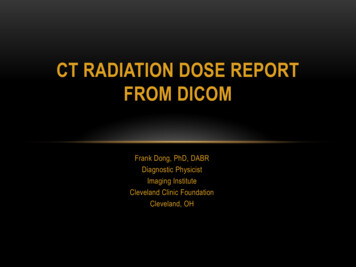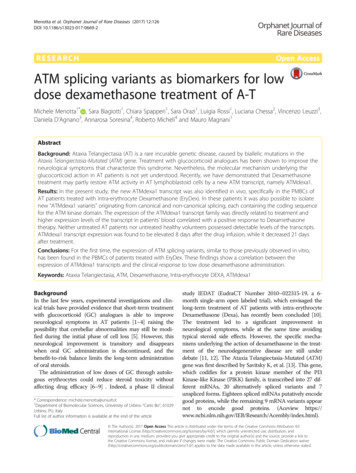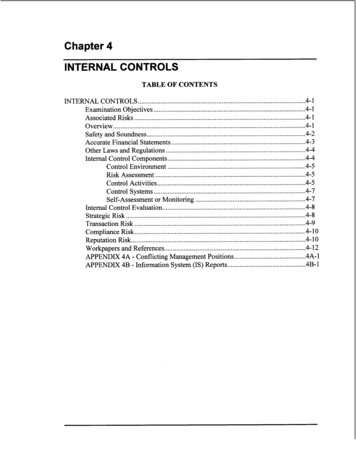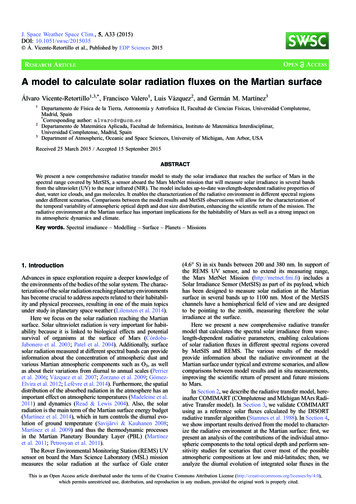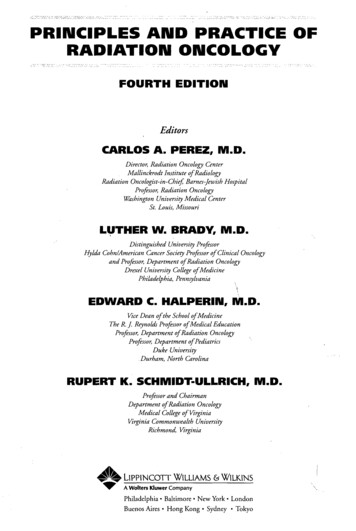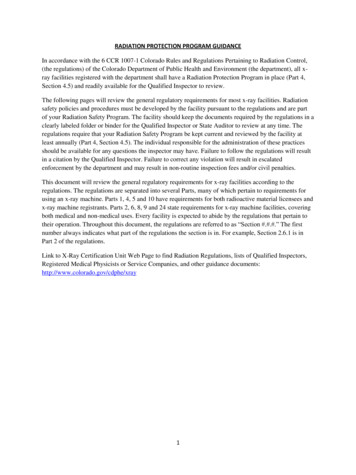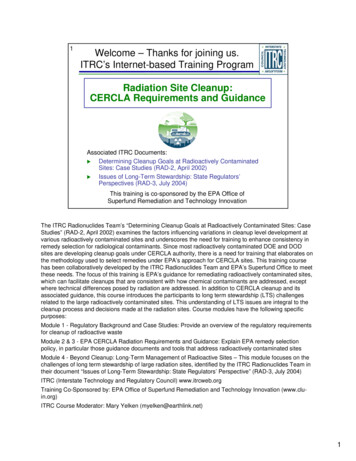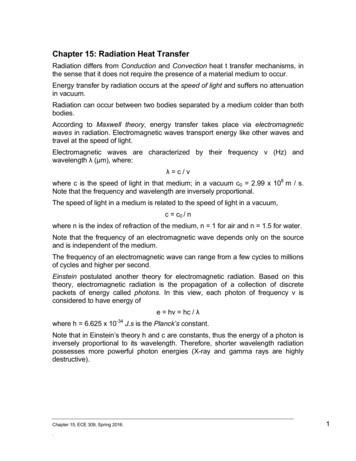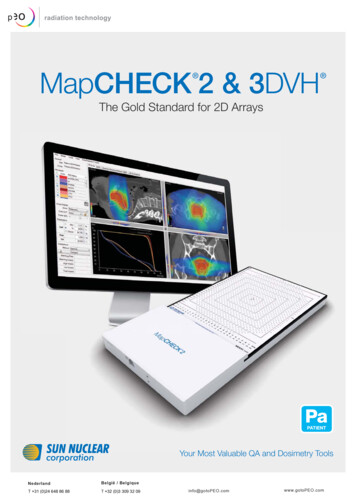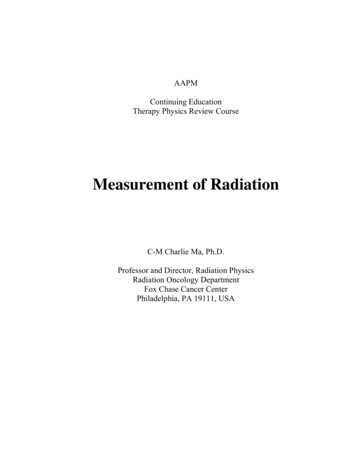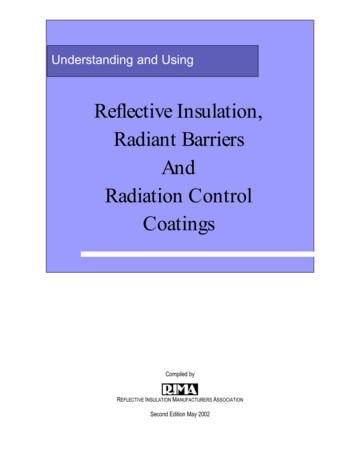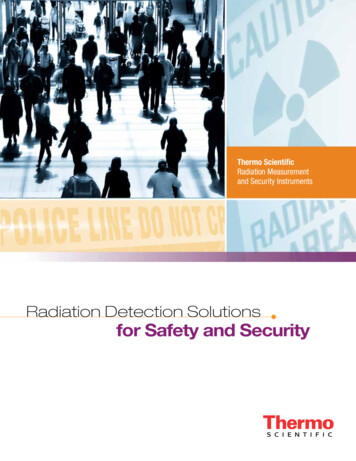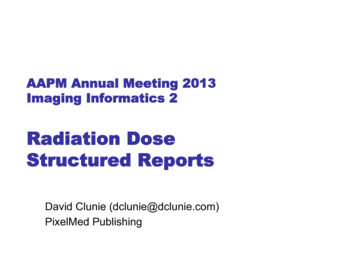
Transcription
AAPM Annual Meeting 2013Imaging Informatics 2Radiation DoseStructured ReportsDavid Clunie (dclunie@dclunie.com)PixelMed Publishing
RDSR – Learning Objectivesl l l l Basic concepts of DICOM structured reporting (SR)Relevant parts and sections of DICOM standardRadiation Dose Structured Report – current & newProposed Patient RDSR
What is a Structured Report?l l A “report” with “structure”What is a “report”? dictated by a radiologist (or other human) plain text /- voice recognition “evidence documents” from machine/operator CAD, ultrasound, coronary CT measurementsl What is “structure”? outline, headings, nesting measurements, codes, references, locations
What is a DICOM StructuredReport?l A “structured report” encoded in DICOMl As distinct from a rendered reportl Other formats that encode structure structured data is recoverable printed, sent as plain text, PDF “pretty” but needs a human/NLP to interpret HL7 Clinical Document Architecture (CDA) home-grown XML (proprietary schema)
A “Structured Report” toEncode as a DICOM SRChest X-ray Report:Recording Observer: Clunie David A Dr.History: malignant melanoma excised 1YFindings:- finding: multiple masses in both lung fields- best illustration of findings:Conclusions:- conclusion: cannon-ball metastases- conclusion: recurrent maligant melanomaDiagnosis Codes:- diagnosis: 172.9/ICD9- diagnosis: 197.0/ICD9
Tree of DICOM SR Content“Chest X-Ray Report”1.11.2Context!“Recording Observer” “Clunie David Dr !“ Acquisition Subject” “Homer Jane ”PNAMECODEProperties!“diameter” “1.3” Contains!“conclusion” “probable malignancy”Modifier!Infd From!“Views” “PA and Lateral”CODECONTAINER“best illustration of findings” AGE“Specific Image Findings”1.7.1NUM“margination” “infiltrative”“Baseline” Contains!PNAME“Study Instance UID .” “1.2.3.4.5.6.7.100”“Finding” “Mass”1.4.11.5CONTAINERSeld From!IMAGESCOORDInfd From!1.6.1.2CODE
Rendered form of DICOM SRReport of Chest X-Ray (PA and LateralViews)""Patient Jane Homer"Study # 123456"Recorded by Dr. David Clunie""The finding is a mass measuring 1.3 cm in diameter with an infiltrative margin.""The baseline image is shown at"(Click to view)""Conclusions"The conclusion is a probable malignancy, inferred from the infiltrative margin of themass and the appearance shown by the best illustration of findings.""Specific Image Findings"(Click to view)"The best illustration of findings is "
SR Content is a Tree1Root NodeChild Nodes1.11.2
Each SR Node (Content Item)l Is a “name-value” pairl The (concept) “name” is always codedl The “value” may be one of several“value types” e.g. “finding” “mass” e.g. (121071, DCM,“Finding”)
Value Typesl l l l l l l TEXTCODENUMPNAMEDATETIMEDATETIMEl l l l l l l l DTCOORD
Nodes linked byRelationships1Parent NodeRelationshipsChild Nodes1.11.2
Relationshipsl l l l l l l ContainsHas PropertiesInferred FromHas Observation ContextHas Acquisition ContextHas Concept ModifierSelected From
Codes – Leverage StandardExternal Lexiconsl SNOMEDl LOINC e.g., for anatomy (T-D4000, SRT, “Abdomen”) e.g., for procedures (36952-0, LN, “Abdomen and Pelvis CT WO contrast)e.g., for observations (8867-4, LN, “Heart Rate”)l UCUMl DICOM-defined codes when no others for units, e.g., (mGy.cm, UCUM, “mGy.cm”) (113813, DCM, “CT Dose Length Product Total”)
DICOM SR IODsl Information Object Definitions (PS 3.3)General purpose – any templatel Specific – require specific templatel Basic Text, Enhanced, Comprehensive Mammography CAD Radiation Dose
DICOM SR Templatesl Tabular form (PS 3.16)What “containers” (tree structure/depth)l Which content items (name-value pairs)l What value sets (context groups)l grouping and nesting of content items required or permitted what codes to use for name what codes to use for values
Example DICOM SR Template
Example DICOM SR ContextGroup (Value Set)
Example DICOM SR CodeDefinitions
How DICOM SR is Encodedl l l l l l l Tree representation “layered” on top oftraditional DICOM Data SetIs “object” (SOP Instance) like an imageNo Pixel DataContent Sequence instead (recursive)Each “content item” is a sequence itemAttributes defined by Value TypeConstrained by IOD and templates
RDSR – Practical Mattersl l l l l l l Layering of SR on DICOM data elementsMakes creation/parsing “non-trivial”Hand-coding it would be “inefficient”Use a toolkit with DICOM SR supportUse a toolkit with RDSR supportConvert to something else structuredXML XPath (XSL-T) for extraction
RDSR Toolkit Examplel CreateCTDose ctDose new CTDose( );ctDose.setDLPTotal(4030.6);l ReadAttributeList list new AttributeList(); list.read(file);CTDose ctDose new CTDose(list);ctDose.getDLPTotal();
SR Toolkit Examplel CreateContentItem dlptoti new NumericContentItem(parent,"CONTAINS”,new CodedSequenceItem("113813","DCM","CT Dose Length Product Total"),4030.6,new ;
XML Conversion Example DicomStructuredReport DicomStructuredReportContent container ID "ci 1.12" continuity "SEPARATE"relationship "CONTAINS” concept cm "CT Accumulated Dose Data" csd "DCM" cv "113811" / num ID "ci 1.12.2" relationship "CONTAINS" concept cm "CT Dose Length Product Total" csd "DCM" cv "113813" / value 4030.6 /value units cm "mGy.cm" csd "UCUM" csv "1.4" cv "mGy.cm" / /num /container
XML Conversion ExampleDocument srDocument ntainer[concept/@cv '113701' and @csd 'DCM']/container[concept/@cv '113811' and @csd 'DCM']/num[concept/@cv '113813' and @csd �//num[concept/@cv '113813']/value”,srDocument);
Toolkitsl l l l l l API – RDSR, SR, XML, XPath, XSL-TCommand line utilitiesGUI utilitiesValidators (IOD, template conformance)PixelMed Java toolkit (mine)OFFIS dcmtk C
Legacy and OCRl Other places dose sometimes lives l Conversion tools to make RDSR image headers Modality Performed Procedure Step (MPPS) dose “screen” secondary captures
Dose Utility Prototype
RDSR & OCR or MPPS ertRDSRQ/RQ/RScreenRDSRRDSRRDSRDoseReporter
IHE REM ProfileDoseRegistry [RAD-63] Submit Dose InformationDose InfoReporter [RAD-64] Query Dose Information [RAD-65] Retrieve Dose InformationImageArchiveImageManager [RAD-64] Query Dose Information [RAD-65] Retrieve Dose InformationDose InfoConsumer [RAD-62] Store Dose Information [RAD-10] Storage CommitmentAcquisitionModality [RAD-62] Store Dose Information
Conclusionl l l l l l DICOM RDSR is the accepted standard for encodingmodality dose information, including for registriesAll new and current platform CT modalitiesA template on top of DICOM SRDICOM SR may appear daunting, but with the righttoolkit is straightforward to create, parse, analyzeand renderContent available as “merge fields” in VR systemsRDSR is comprehensive and extensible to newcontent and new concepts
DICOM SR may appear daunting, but with the right toolkit is straightforward to create, parse, analyze and render ! Content available as “merge fields” in VR systems ! RDSR is comprehensive and extensible to new content and new concepts . Title: AAPM_2013_RDSR_Clunie.pptx Author .
